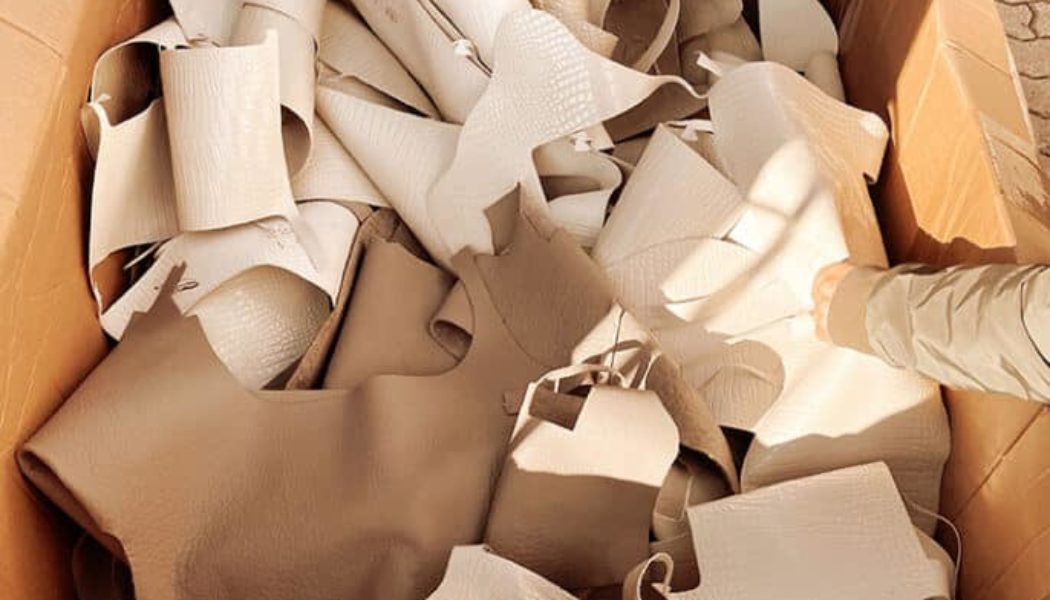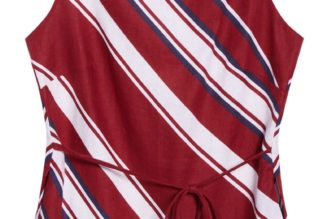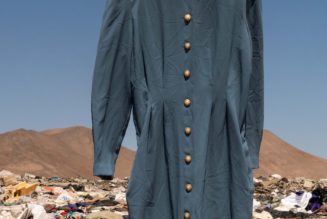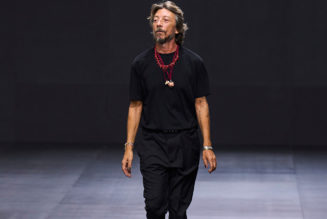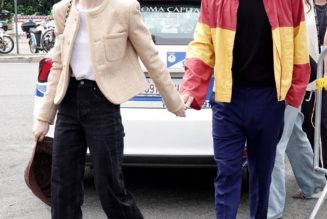When we think of fashion and leather goods, we don’t usually think about sustainability. For the majority of people who can’t afford designer “investment pieces” that are timeless and high quality—pieces that are purchased once and worn or used for years to come, and that typically cost much more than average pieces—fashion is about finding cheap and easy ways to replicate runway trends and designs. It’s anything but sustainable.
“Fast fashion,” as it’s called, is by its very nature disposable. We love it for a short time, but we grow tired of it quickly and then dispose of it to make way for the newest trend, which means that most of it (around 73%) ends up in landfills. But it gets worse. The increasing push toward “cruelty-free” and “vegan” leathers, most of which usually contain phthalates and other chemicals and toxins and can take thousands of years to break down, has resulted in an increasing amount of excess real leather waste given the decrease in leather sales in favor of these supposedly more ethical leathers. A staggering amount of these leather hides—millions, in fact—also end up being thrown away. And these are hides that exist as a biproduct of the meat industry. In other words, buying “vegan” leather doesn’t mean you’re saving a cow. It simply means that you’re sending a hide that would otherwise be used to the landfills or to be burned. Given these facts, it’s easy to wonder what are the most ethical choices when it comes fashion.
If you’re doing the math, then you should be horrified. It’s exactly how I felt when I attended a talk on sustainability and the fashion industry in Florence, Italy in the fall of 2021. One of the speakers was Cassandra Kane, an American Jewish woman who grew up in New Jersey and worked in the luxury fashion industry in New York City before moving to Florence six years ago.
I recently met with Kane to chat about fashion, sustainability, and Sieme and Zero Lab, her creative solutions to the tremendous amount of waste in the leather industry. For Kane, the “worst part about ‘fast fashion’ is that it devalues the true cost of garments and products so that customers can no longer appreciate their true value. If we have the expectation that a shirt costs $5 or $10, why would we value and take care of that garment in the long term? The truth is, that price can only be achieved through exploitation of natural resources and labor and ‘fast fashion’ has essentially trained two to three generations of people that this is OK,” she said. “The ‘fast fashion’ model doesn’t work when you need to provide for people, planet and profit.”
Many of the most popular “fast fashion” brands (like Zara, and H&M for example) like to talk a lot about sustainability because it’s trendy and buzz-worthy. However, these retailers and others fall far short of their alleged goals. But for Kane, a designer and entrepreneur, sustainability is not just a buzz word. It’s a way of life, and she’s figured out how to make it a way of life for others as well—without sacrificing quality and aesthetics.
When I first heard Kane talk about the leather industry, which is substantial in Florence, I was shocked by her comments on vegan leather. Given the mass amount of marketing for these products—and the touting of them by celebrities like Miley Cyrus, Kim Kardashian, and Meghan Markle—I have to admit I’ve felt more than a touch of guilt over all of my beloved leather boots and jackets. But the truth is that vegan leather is much more damaging to the environment than real leather.
“The vast majority of vegan leather that’s on the market has plastic in it in some way,” said Kane. It’s not as sustainable or ethical as we’ve been led to believe. But “there’s a way to have ethical real leather” because as a material, “leather is technically biodegradable and lasts longer than any vegan leather will ever last if you take care of it because it can be repaired. It can be passed down through generations, and so in that respect it’s one of the most durable materials. There’s a reason we’ve been wearing it since the dawn of time.”
Understandably, some might still find the environmental impact of vegan leather less egregious than the alternative, which in theory requires killing an animal. But even that isn’t what it seems.
“What most people don’t know is that over 90 percent of leather that’s used in the fashion industry is a biproduct of the meat industry. So if we weren’t utilizing the leather then it would be getting thrown away,” said Kane. “Leather is like an added bonus to meat industry … last year in the U.S. we burned or buried five million hides that just weren’t used because, overall, the desire for leather goods is going down because there are a lot of alternative materials on the market.”
“Leather is like an added bonus to meat industry … last year in the U.S. we burned or buried five million hides that just weren’t used because, overall, the desire for leather goods is going down because there are a lot of alternative materials on the market.”
Think about it: five million hides burned or buried, just last year alone, in the U.S.
But it’s complicated. As we know, the meat industry is a massive contributor to air pollution and other environmental concerns. And so, as Kane says, the problem isn’t leather; it’s that we need to eat less meat in general. “For the last 30 years our meat consumption has continued to rise,” she said. And “you can’t talk about using less leather without talking about eating less meat. The two go hand in hand.”
But for now, with levels of meat consumption as they are, the question is how to avoid the tremendous amount of waste that the leather industry is known for. This is where Sieme, Kane’s artisan Italian accessories company, comes in. Sieme re-purposes and uses luxury fashion’s leather off-cuts to make beautiful handbags and other accessories.
“On average, 20-40 percent of leather used in accessories production is discarded in the process. In Italy that can go up to 60 percent because of quality control issues and because when you have really high markup you’re not as incentivized to utilize all the material you need and reduce the consumption for cost the same way you are if you’re more mass market or contemporary design level,” said Kane. “But in luxury … it doesn’t matter. In Tuscany alone that equals over 260 tons a year of leather that gets thrown out (400,000 pounds a year).”
And what happens to it when it gets thrown out? What does that mean, and where does it go?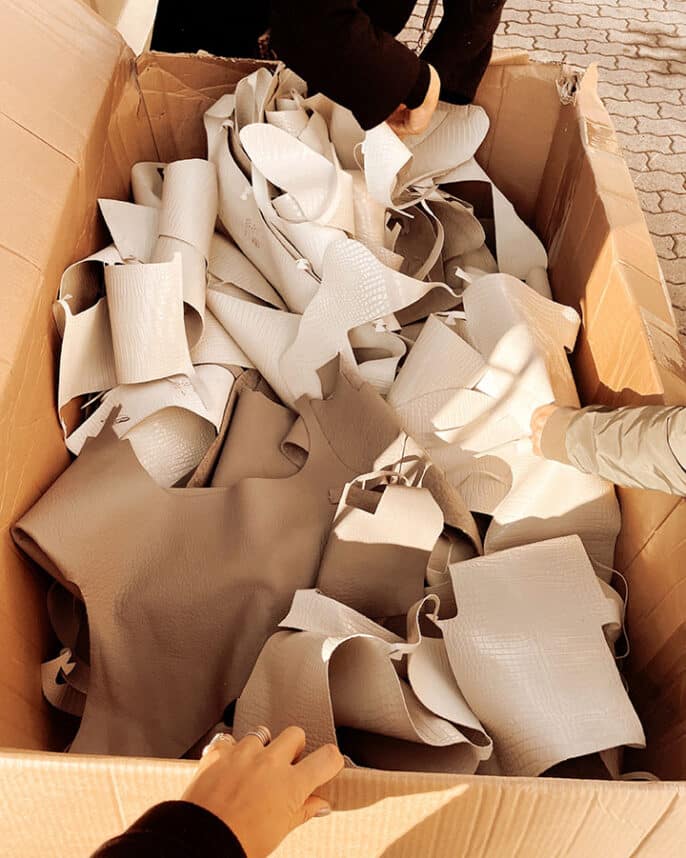
It goes through a “disposal” process. “Leather is considered industrial waste because of the way it’s tanned. If it’s vegetable tanned leather [where natural tannins are used—which only give us muted colors rather than the whites and bright colors] … it becomes fertilizer.” But vegetable-tanned leather makes up less than 20 percent of leather that’s used in the fashion industry. The “vast majority of leather uses chemicals for tanning and can’t get thrown out normally. It has to go through a dechroming process to become biodegradable, which is expensive and which they do here in Italy, but in a lot of other countries they don’t. Or it gets sent to special landfills more often than not, or it gets sent to be incinerated because it makes very good fuel to burn other trash.”
Leather may be biodegradable, and an obviously more environmentally sound choice than so-called vegan leather, but when treated with chemicals it can still pose a substantial threat to the environment when it’s burned or buried. And beyond that, it’s a tremendous act of waste. But, as Kane says, there’s always going to be a little bit of waste. The idea of having “absolutely zero waste is not realistic.” But given that leather is such a “high value material,” we should be able to find a use for it, and “60 percent waste is insane.”
It’s horrifying. But even though this kind of waste is now finally on the fashion industry’s radar, Kane admitted that it’s hard to process until you see it for yourself—until you are in the industry and traveling to factories and witnessing how production works and what happens to the discards.
“My aha moment with leather didn’t come until I was working in a factory, and it was a very small factory [after she studied at Florence’s prestigious Scuola di Cuoio] that makes high-end samples for runway shows in very small production and we were working for one specific brand and we ended up having to throw away 60 percent of the leather they ordered because they couldn’t accept it … it was a very natural leather and there were a lot of wrinkles and changes to the texture and they wouldn’t accept it,” she said. “And I was like, wait a second, and it really did click that if this is happening here, this must be happening on a massive scale.”
Kane, who comes from a long line of people in the fashion industry—her grandmother was a seamstress, her grandfather was a tailor, and her mother worked in a designer showroom—has always been attracted to leather and “hard piece fabrics.” She was a leather, fur (although she believes we should no longer be using fur), and outerwear designer in NYC. Her first job in the industry was with Dennis Basso, and she remembers asking the designer why he would take so long to make each piece, and his response was that all of the materials being used came from life, and so his job was to respect it and do it in the best possible way he possibly could. This lesson stayed with Kane. So when she witnessed for herself the extreme level of waste, she knew there had to be a way to reduce it while creating quality and beautiful products.
At Sieme, “we weave or manipulate all the leather … because when dead or excess materials are being used, there’s a finite amount, so we have to figure out a way to manipulate or design it so that you can scale it.” Kane was really inspired by weaving because the method was born here in Tuscany hundreds of years ago, and “the reason they used to weave leather is here because in Tuscany specifically they don’t have a lot of cows—traditionally they always had lamb—and they ate a lot of lamb and that’s why there’s pecorino cheese. Now they have cows too, but they always had a lot more sheep in Tuscany. And so they had sheep leather, and sheep leather is way softer but it was too soft for bags and shoes, so what made it stronger was weaving it together … I wanted to take that and turn it around and say, well also all of this discarded leather is not waste; it’s just off-cuts really.”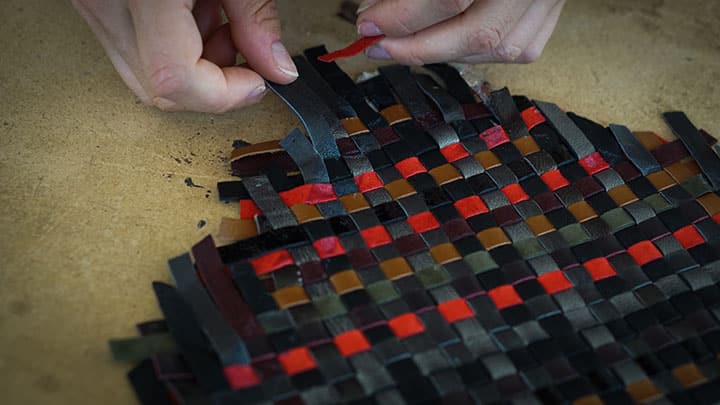
The behind-the-scenes process of how leather goods are made is eye-opening, to say the least. Some of the “luxury brands will take an entire lambskin and cut one front panel in the back and middle of the skin and the rest of it they throw away, because when you’re selling a bag for 8,000 euros or dollars it has to be perfect. And the cost doesn’t matter. So that’s what we’re working with. And sometimes we’re working with whole skins because … every production orders ten percent more than what they need in case there are defects or something happens.”
When we consider that this is not only happening in Tuscany but all over the world, it becomes clear that this is not just a local project. It has to be a global or industry-wide effort.
To facilitate this process of gathering and re-purposing leather off-cuts from designer and luxury brands, Kane realized she needed to build an infrastructure, so she started Zero Lab, a hub for the recycling of leather waste. “Just this week we got a shipment from a factory that was 15 giant boxes of full rolls of leather that was accumulated over seasons but they have no use for it.” Zero Lab is not just a leather recycling studio; it’s also a sustainable design hub and creative working space for emerging designers and smaller brands that are interested in working with “waste” and offcuts. One of their first big partners is Gucci. The hub is also developing other projects that are business to business and trying to find more ways to keep leather out of landfills. “We are also working on a project where we’re quantifying the amount of carbon that’s saved by keeping this stuff in circulation as opposed to just sending it to landfills and then it getting burned and used as fuel to burn other trash.” Kane hopes to be able to help companies in the future be able to quantify the amount of carbon that their products are using.
The mission is simple: “It’s keeping leather out of landfills and making the industry more circular and sustainable. And number two, supporting artisans, independent designers, emerging designers, and small artisans here in Florence” because over decades many companies have bought up small factories and absorbed them. “We don’t want to lose that culture … it’s what makes Italy Italy. We’ll never get the next generation of designers and brands who are going to be able to move the needle and make the industry more sustainable if they have no way to start. So that’s the big way that Zero Lab comes in. It’s finally a place for all these people to come together.”
Kane’s vision is a big vision. It’s not just wanting to be in Florence and Tuscany and make beautiful bags. “It’s a mitzvah,” I said to Kane. And there really is a strong tikkun olam component to everything Kane does. A cornerstone of Judaism and Jewish identity is the idea of ethical responsibility. What Kane is doing epitomizes this. It’s one thing to make personal decisions to buy only sustainable products, but it’s another to thing altogether to make it your life’s work, to make it easier for other people to make ethical decisions.
It’s one thing to make personal decisions to buy only sustainable products, but it’s another to thing altogether to make it your life’s work, to make it easier for other people to make ethical decisions.
It’s also true that the commandment of bal tashchit—do not destroy or waste—is crucial to a Jewish environmental ethic. The Jewish tradition forbids wasteful behavior because it contributes to the degradation of the planet. It’s the opposite of tikkun olam. Needless destruction and the act of destroying anything that may be of use to people are prohibited. It applies to wasting energy, clothing, water, money, and wastefully burning oil or fuel.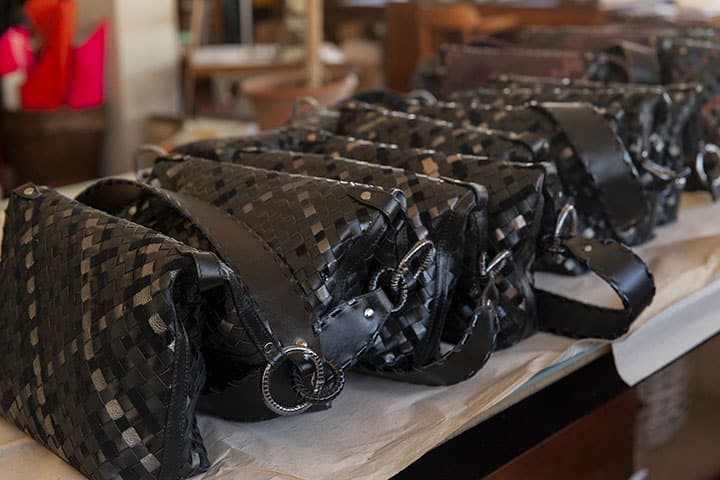
I had to ask Kane: Do you think that being Jewish has impacted what you do or why you do it?
Her response: “Yeah, my mom and my bubbe always engrained in us to give back, to volunteer. And it was always through the Jewish community in some way whether nursing homes or different organizations, or with USY—because that’s a big part of what they do, you give back in so many different ways—and so I do think that it’s your responsibility to leave world a little bit better than how you found it, or at least try to.” Kane is passionate about fashion, and says, “Every time I sit at a sewing machine I think of my bubbe. It feels very natural that the way I’m going to try to give back and solve a problem is within that industry because I feel very connected to it on a much deeper level.”
On social media, Kane offers hilarious and compelling critiques of couture fashion. She also gives an insider’s view of her life in Italy (she is currently planning a wedding with her Italian fiancé Lorenzo) and as a designer and entrepreneur. But most notably, she is unabashedly Jewish. One of my favorite moments was her description of how she had been dying to take Lorenzo home for a Jewish holiday, but the holiday that worked ended up being Yom Kippur, the one holiday where Jews don’t eat. One can imagine that the idea of not eating on a holiday must be confusing for Italians.
Kane grew up in a conservative Jewish community and spent a lot of time at the synagogue, where her mom ran the gift shop and was president of Sisterhood, and her dad was equally involved. Kane went to Camp Ramah and was active in USY on Wheels. The city in which she lived was around 40 percent Jewish. Later she lived in New York City, another place of high Jewish visibility, where the markets are filled with Jewish foods. It’s easy to take being Jewish for granted in such an environment. “I always really liked being Jewish,” Kane said, “and I didn’t really have to think about it so much.”
But living in Italy as a Jew is much different. For example, Kane started cooking Jewish foods in Italy because she couldn’t find them. “If it’s important to you to do, you have to make the time,” she said. “To find all the stuff to make matzo ball soup at Passover is a commitment, and in a way it makes it more important.” To be Jewish in Italy requires being more intentional. It doesn’t happen automatically; you have to seek it out. Kane regularly interacts with people who’ve never met someone who is Jewish, or if they have they’ve only encountered Hasidic or Lubavitch Jews, people who are visibly Jewish. But she enjoys exposing people to Jewish identity in a place where the word for “Jewish” doesn’t really exist. In Italian, the word is “ebreo,” which translates as “Hebrew.” It’s not the same thing. But sometimes Jewish identity can be discovered or re-discovered in the unlikeliest of places. “I’m forced to think about it a lot more here,” said Kane. “I appreciate it more.”
Kane is carving out her an important space and doing something that really matters without sacrificing creativity. We should all feel inspired.
